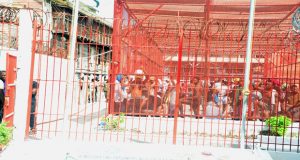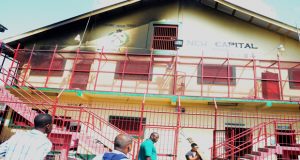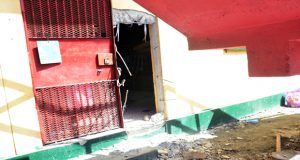Never again! …senior cop decries prison ruckus

CONTRACTORS from the Ministry of Public Infrastructure have commenced working to repair the various damaged sections of the Camp Street Prison following two days of deadly rioting by inmates over poor living conditions. And a senior police officer has said that the tragedy should never be allowed to happen again.
On Thursday, 17 prisoners died after being trapped in a burning room. On Friday, several others restarted the protest using large pieces of wood to break concrete walls, and their feet to stomp out boards from the prison walls. Some of the inmates even ended up in the yard of the prison. They were, however, restricted from making their way to the access point that leads to the various exits of the prisons, since there is reinforced metal and grill work within the facility. While in the yard, the inmates armed themselves with improvised weapons made from various objects, and with shovels and cutlasses which they managed to acquire from the tool shop of the facility, which they also managed to break into.
Among the items destroyed inside the facility following the unrest were steel doors, metal work and a tailor’s shop. Extensive damage was also done to the Capital ‘A’ Section of the prison, to an adjoining area, and to the northern wall facing Bent Street and the southern wall facing Durban Street.
By midmorning yesterday, engineers from the Ministry of Public Infrastructure had showed up at the facility, met with prison officials, and had proceeded to assess the damage to the facility. By noon they had already procured materials and had commenced works to restore the damaged areas.
According to an officer, intense discussions were also held on how the present infrastructure at the facility can and ought to be strengthened.
A section of the Camp Street Prison wall facing Bent Street, which the prison inmates stomped out on Friday morning
A section of the Camp Street Prison wall facing Bent Street, which the prison inmates stomped out on Friday morning
A top Joint Services officer said the lawmen did all they could to save lives on Thursday. The senior police officer spoke with this newspaper on condition of anonymity, given that the investigations are still in progress and a Commission of Inquiry is soon to be set up, as ordered by the Commander in Chief of the Armed Forces, President David Granger.
The officer said that since Wednesday night the prisoners had begun expressing frustration with the manner in which certain procedures were being handled at the facility, especially by those tasked with manning the operations of the Georgetown Prison. That led to the setting of fires and throwing of missiles at wardens who attempted to bring the situation under control.

The officer explained that on Thursday, what transpired could hardly have been avoided with respect to the deaths of the inmates, as the way they had barricaded themselves into the cell made it difficult for them to free themselves after the fire had become uncontrollable.
The inmates had used metal beds to block a metal door, so even though prison wardens had been able to unlock the door with the key, they could not push it open as it was firmly barricaded from within.
It was explained that the inmates compressed the metal beds against each other, so pulling them apart to get access to the door was harder than actually placing the beds to barricade the door and prevent access into the room.
That forced firefighters, aided by other Joint Services’ members, to blow torch the lower part of the door, through which the injured crawled out. Once that was done, Joint Services’ ranks entered the room after the fire was completely extinguished, removed the barricades, and pulled the door open. It was then that the charred remains of the sixteen persons were discovered, the expert explained.
One of the holding areas inside the Camp Street jail, which is presently under repair due to destruction caused by the unrest
One of the holding areas inside the Camp Street jail, which is presently under repair due to destruction caused by the unrest
The officer explained that everything that could possibly have been done to save the prisoners had been done. “What happened on Wednesday, Thursday and this morning [Friday] should be taken very seriously, and efforts ought to be put in place to ensure that this never happens again in the history of this country.
“This type of behaviour only results in the loss of lives, sustaining of serious injuries, and damage to state property,” the officer explained.
The Guyana Chronicle was told that none of the inmates was placed in solitary confinement, although at least one person who was thought to be influencing some of the other inmates was placed in a section of the prison away from the rest of the population. This newspaper was told that “Grey Boy”, who is on remand for the murder of Courtney Crum-Ewing, was very vocal during the unrest. He was not one of those who met Public Security Minister Khemraj Ramjattan and Minister of State Joseph Harmon, when they visited the location on Friday.
A hole in a concrete wall, made by inmates with the use of planks
A hole in a concrete wall, made by inmates with the use of planks
No inmates received life-threatening or serious injuries during the operation on Friday morning, but there were those who suffered injuries from pellets while others were affected by smoke from the tear gas, this publication was told.
During Friday’s incident, two police constables were injured by missiles which the prisoners hurled at them. Those missiles included bricks and metal which had been broken off from the facility’s door and walls. Six prison officers were affected by tear smoke, which the police used as one of their means to bring the inmates under control. Twenty-four prisoners were injured as a result of smoke and pellets which were used.
According to information, there were approximately 200 Joint Services ranks engaged in the operation to bring the situation under control. Up to yesterday afternoon, arrangements were being made to transfer young offenders to the Timehri Prison. There was no attempt to send anyone at Mazaruni, at least not up to press time, this publication was reliably informed.

